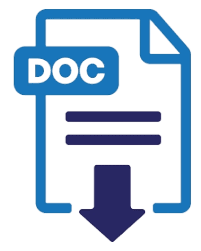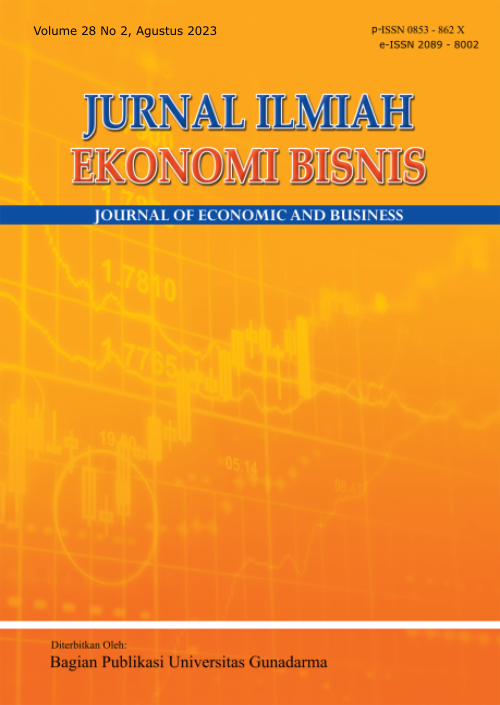PENINGKATAN KINERJA MELALUI TRANSFORMASI DIGITAL LAYANAN PUBLIK KEPABEANAN YANG DIPERKUAT DENGAN BUDAYA DAN POLA KERJA ADAPTIF

https://orcid.org/my-orcid?orcid=0000-0002-3321-2240
Gunadarma University
Indonesia
Gunadarma University
Indonesia
Abstract
Kinerja organisasi menjadi muara dalam proses transformasi digital layanan publik yang telah dilakukan dalam beberapa tahun terakhir. Namun demikian masih kedapatan kinerja yang perlu perbaiki. Indikator kinerja tersebut dapat dilihat dari kepuasan pengguna jasa, efisiensi layanan dan juga target lain dalam key performance indikator. Penelitian ini bertujuan untuk menganalisis dan memperluas pemahaman tentang dampak budaya organisasi yang adaptif dan pola kerja adaptif dalam mendorong transformasi digital untuk meningkatkan kinerja organisasi, mengembangkan program budaya dan opsi pola kerja yang efektif sebagai strategi meningkatkan kinerja selama proses transformasi digital. Studi ini menggunakan pendekatan mix method, metode kuantitatif untuk menguji hipotesis, sampel purposif pemeriksa Bea Cukai. Pendekatan kualitatif dengan observasi dan focus grup discussion sebagai konfirmasi dan memperdalam penelitian tersebut. Temuan dari penelitian ini adalah: budaya adaptif dan pola kerja berpengaruh kuat terhadap transformasi digital untuk mendorong kinerja, terutama nilai stakeholders focus, kolaborasi dan pengembangan diri, kemudian transformasi digital dapat memediasi budaya adaptif dan pola kerja dalam meningkatkan kinerja organisasi lebih baik.
Keywords
References
Aldrich, H. E., & Ruef, M. (2006). Organizations evolving (2nd ed.). Washington DC: Sage Publications Ltd.
Alvesson, M. (2002), Understanding organizational culture. London: SAGE Publications.
Amin, M.A.M. (2010). Measuring the performance of Customs Information Systems (CIS) in Malaysia. World Customs Journal, 4(2), 89-104.
Ashikali, T., & Groeneveld, S. (2015). Diversity management in public organizations and its Effect on employees’ affective commitment: The role of transformational leadership and the inclusiveness of the organizational culture. Review of Public Personnel Administration, 35(2), 1-37. doi.org/10.1177/0734371X13511.
Fransiska, A. & Wijayanty, D. (2014). The influence of service performance on customer satisfaction of Bank Central Asia in Surabaya. International Journal of Advances in Management and Economics, 3(6), 57-64.
Austin-Egole, I.S., Iheriohanma, E.B.J., & Nwokorie, C. (2020). Flexible working arrangements and Organizational Performance: An overview. IOSR Journal of Humanities and Social Science, 25(5), 50-59. doi.org: 10.9790/0837-2505065059.
Azis, I. J. (2019). Economics and culture. Bulletin of Monetary Economics and Banking, 22(1), 123 – 132. doi.org/10.21098/bemp.v22i1.1035
Balandina, G.V, Ponomarev, Y.Y., Sinelnikov-Murylev, S.G., & Tochin, A.V. (2018). Customs administration in Russia: Directions of improvement. Economic Policy, Russian Presidential Academy of National Economy and Public Administration, 3, 106-131.
Barney, J. B., & Hesterly, W. S. (2015). Strategic management and competitive advantage. New Jersey: Pearson-Prentice Hall.
Blocher, E. J., Chen, K. H & Lin, T. W. (2005). Cost management: A stategic emphasis. (International Edition). New York: McGraw-Hill Companies, Inc.
Cameron, S. K., & Quinn, R. E. (2006). Diagnosing and changing organizational culture: Based on the competing values framework (Third edition). San Fransisco: Jossey-Bass, John Wiley & Sons.
Cheung, C.M.K., & Thadani, D. (2012). The impact of electronic word-of-mouth communication: A literature analysis and integrative model. Decision Support Systems, 54(1), 461-470.
Cho, E. (2020). Examining boundaries to understand the impact of COVID-19 on vocational behaviors. Journal of Vocational Behavior, 119(2020), 1-3. doi.org/10.1016/j.jvb.2020.103437.
Costanza, D. P., Blacksmith, N., Coats, M. R., Severt, J. B., & DeCostanza, A. H. (2016). The effect of adaptive organizational culture on long-term survival. Journal of Business and Psychology, 31(3), 361–381. doi.org/10.1007/s10869-015-9420-y
Coyle, T., Cruthirds, K., Naranjo, S., & Nobe, K. (2014). Analysis of current customs practices in the United States and a proposed model for world class customs. World Customs Journal, 8(1), 71-82.
Daft, R.L. (2010). Organization theory and design (10th Edition). USA: South-Western College Pub.
Denison, D., Janovic, J., Young, J., & Cho, H. J. (2006). Diagnosing organizational cultures: Validating a model and method. Research Article. Retrieved from: http://denisonconsulting.com/wp-content/uploads/2019/05/diagnosing_organizational_cultures_validating_a_mo.pdf.
Davidescu, A.A.M., Apostu, S.A., Paul, A. & Casuneanu, I. (2020). Work flexibility, job satisfaction, and job performance among Romanian employees—Implications for sustainable human resource management. Sustainability Journal, 12(15), 1-53. doi.org:10.3390/su12156086.
De Wulf, L., & Sokol, J.B. (2005), Customs modernization handbook. Washington, DC: World Bank.
Dharmawan, A., Susilo T. R., & Kusumawardhani, A. (2018). Analisis kinerja bea cukai Indonesia yang dipengaruhi oleh budaya organisasi, partisipasi stakeholder, teknologi informasi dan transfer knowledge. Jurnal Bisnis STRATEGI, 27(2), 110 – 122. doi.org/10.14710/jbs.27.2.110-122
El Leithy, W. (2017). Organizational culture and organizational performance, International Journal of Economics & Management Science, 6(4), 1-6. doi.org: 10.4172/2162-6359.1000442
Ertz, M., Karakas, F., & Sarigöllü, E. (2016). Exploring pro-environmental behaviors of consumers: An analysis of contextual factors, attitude, and behaviors. Journal of Business Research, 69(10), 3971-3980. doi.org: 10.1016/j.jbusres.2016.06.010
Garrett, L. E., Spreitzer, G. M., & Bacevice, P. A. (2017). Co-constructing a Sense of Community at Work: The Emergence of Community in Coworking Spaces. Organization Studies, 38(6), 821–842. doi.org/10.1177/0170840616685354
Ghozali, I. (2017). Model persamaan struktural konsep dan aplikasi program AMOS 24. Semarang: Badan Penerbit Universitas Diponegoro.
Grainger, A. (2016). Customs management in multinational companies. World Customs Journal, 10(2), 17-36.
Gunasekaran, A., Patel, C. & McGaughey, R.E. (2004). A framework for Supply chain performance measurement. International Journal of Production Economics, 87(3), 333-347. doi.org/10.1016/j.ijpe.2003.08.003.
Guo, L. & Xu, L. (2021). The effects of digital transformation on firm performance: Evidence from China’s manufacturing sector. Sustainability Journal, 13(22), 12844. doi.org/ 10.3390/su132212844.
Gupanova, Y. E., Nemirova, G.I. & Suglobov, A.E. (2018). The analysis of customs services practice in the conditions of the Eurasian Economic Union: Problems and directions of improvement. Journal of Advanced Research in Law and Economics, 9(4), 1259. doi.org/10.14505//jarle.v9.4(34).11
Hair, J.F., Black, W.C., Babin, B.J. & Anderson, R.E. (2009). Multivariate data analysis (7th Edition). New York: Pearson.
Hill. J. E, Jacob. J, Shannon. L, Brennan. R, Blanchard. V & Martinengo G. (2008). Exploring the relationship of workplace flexibility, gender, and life stage to family-to-work conflict, and stress and burnout. Community, Work & Family, 11(2), 165-181.
Hilton, R. W., Maher, M.W., & Selto, F. H. (2003). Cost management: Strategies for business decisions (2nd Ed.). New York: McGraw-Hill Co., Inc.
Holzner, M. & Peci, F. (2012). The impact of customs procedures on business performance: evidence from Kosovo. World Customs Journal, 6(1), 17-30.
Jansson, J. E. (2008), The Importance of change management in reforming customs. World Customs Journal, 2(2), 41-46.
Kelliher, C. & Anderson, D. (2010). Doing more with less? Flexible working practices and the intensification. Human Relations Journal, 63(1), 83-106, doi.org/10.1177/0018726709349199.
Klindzic, M. & Maric, M. (2019). Flexible work arrangements and organizational performance – The difference between employee and employer-driven practices. Journal for General Social Issues, 28(1), 89-108. doi.org/10.5559/di.28.1.05.
Nagel, L. (2020). The influence of the COVID-19 pandemic on the digital transformation of work, International Journal of Sociology and Social Policy, 40(9/10), 861-875. doi.org: 10.1108/IJSSP-07-2020-0323.
Malhotra, N. (2007). Marketing research: an applied orientation, (fifth ed.). New Jersey: Pearson Education.
McLinden, G., & Durrani, A.Z. (2013). Corruption in Customs. World Customs Journal, 7(2), 3- 10.
McShane, S. & Glinow, M.A.V. (2008). Organizational behavior. New York: McGraw-Hill.
Morosini, P. (2004). Industrial clusters, knowledge integration and performance. World Development, 32(2), 305-326.
Mungania, A.K., Waiganjo, E. W., & Kihoro, J.M. (2016). Influence of Flexible Work Arrangement on Organizational Performance in the Banking Industry in Kenya. International Journal of Academic Research in Business and Social Sciences, 6(7), 159-172.
Nickols, F. (2012). Change management 101: A primer. Distance Consulting, Howard. Retrieved from: https://home.att. net/~nickols/change.htm
Okwata, P. A., Wasike, S., & Andemariam, K. (2022). Effect of organizational culture change on organizational performance of Kenya Wildlife Service Nairobi National Park. Administrative Sciences, 12(2022), 1-13. doi.org/10.3390/ admsci12040139
Pangewa, M. (2015). The Influence of the organisational culture toward the performance of local governance. Mediterranean Journal of Social Sciences, 6(6), 307-314. doi.org: 10.5901/mjss.2015.v6n6s4p307
Ramosaj, B., Karaxha, H., & Karaxha, H. (2014), Change management and its influence in the business environment. Iliria International Review, 4(2) 9-10. doi.org:10.21113/iir.v4i2.43
Richter, A., & Riemer, K. (2013). Malleable end-user software. Business and Information Systems Engineering, 5(3), 195–197. doi.org/10.1007/s12599-013-0260-x.
Schein, E. (2018). Organizational culture and leadership. San Francisco: Published by Jossey-Bass A Wiley.
Sorensen, J.B. (2002). The strength of corporate culture and the reliability of firm performance. Administrative Science Quarterly, 47(1), 70-91. doi.org/10.2307/3094891.
Taylor, J. (2014), Organisational culture and the paradox of performance management. Public performance & Management Reviewer, 38(1), 7-22. doi.org: abs/10.2753/PMR1530-9576380101.
Teng, X., Wu, Z. & Yang, F. (2022). Impact of the digital transformation of small- and medium-sized listed companies on performance: Based on a cost-benefit analysis framework, Hindawi Journal of Mathematic, 2022, 1-14. doi.org/10.1155/2022/1504499
Testa, M. & Sipe, L. (2013). The organizational culture audit: Countering cultural ambiguity in the eervice context. Open Journal of Leadership, 2(2), 36-44. doi.org: 10.4236/ojl.2013.22005.
Truong, Y. & McColl, R. (2011), Intrinsic motivation, self-esteem and luxury good consumption. Journal of Retailing and Consumer Services 18(6), 555-561. doi.org/10.1016/j.jretconser.2011.08.004
Tuukkanen, V., Wolgsjö, E., & Rusu, L. (2022), Cultural values in digital transformation in a small company. Procedia Computer Science, 196(2022), 3–12. doi.org: 10.1016/j.procs.2021.11.066
Wibowo. (2013). Manajemen kinerja (Edisi ketiga). Jakarta: PT Raja Grafindo Persada.
Yilmaz, C., & Ergun, E. (2008). Organizational culture and firm effectiveness: An examination of relative effects of culture traits and the balanced culture. Journal of world business, 43(3), 291-293. doi.org/10.1016/j.jwb.2008.03.019.
Zhang, J., Long, J., Martina, A., & Schaewen, E.V. (2021). How does digital transformation improve organizational resilience?. Sustainability, 13(20), 1-22. doi.org:10.3390/su132011487.
Zheng, W., Yang, B. & McLean, G. (2010). Linking organizational culture, structure, strategy, and organizational effectiveness: Mediating role of knowledge management. Journal of Business Research, 63(7), 763-771. doi.org/10.1016/j.jbusres.2009.06.005
Zikmund, W.G., Babin, B. J., Carr, J.C. & Griffin, M. (2009). Business research methods. Cincinnati-USA: South-Western College Publication.


